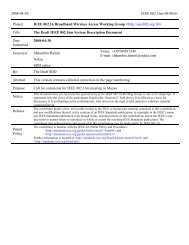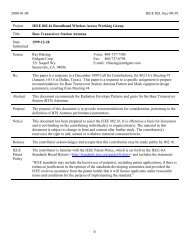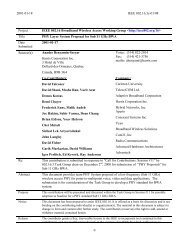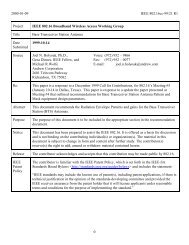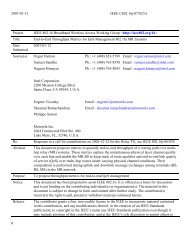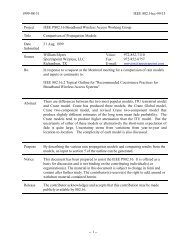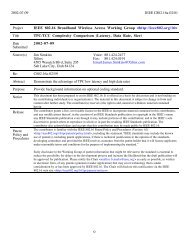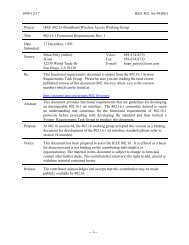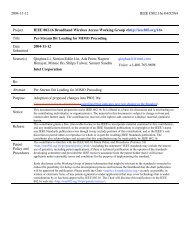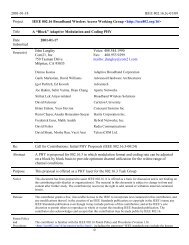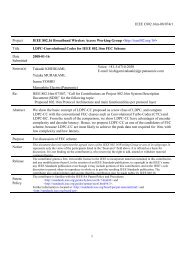Download - LMSC, LAN/MAN Standards Committee
Download - LMSC, LAN/MAN Standards Committee
Download - LMSC, LAN/MAN Standards Committee
Create successful ePaper yourself
Turn your PDF publications into a flip-book with our unique Google optimized e-Paper software.
least 110 Mbit/s. It appears likely that, if the work proceeds, the enhanced PHY will<br />
be based on ultra-wideband communications.<br />
Finally, the 802.15 Working Group is developing yet another independent<br />
wireless PAN in Project 802.15.4. This will specify a low rate PAN supporting rates<br />
up to 250 kbit/s with very low power consumption (for battery life on the order of<br />
months or years) and low complexity (targeting costs of US$2 per radio).<br />
Applications are expected in sensors, toys, and location tracking. A draft standard is<br />
in ballot.<br />
IEEE 802.16 Wireless Metropolitan Area Networks (Wireless <strong>MAN</strong>s)<br />
The IEEE Working Group 802.16 on Broadband Wireless Access (BWA)<br />
has developed the Wireless<strong>MAN</strong> air interface standard<br />
to support the development and deployment of wireless metropolitan area networks.<br />
The Working Group is primarily addressing applications of wireless technology to<br />
link commercial and residential buildings to high rate core networks and thereby<br />
provide access to those networks. This link is sometimes known colloquially as the<br />
“last mile.”<br />
The Working Group’s first air interface project was completed with the April<br />
2002 publication of IEEE Standard 802.16: Air Interface for Fixed Broadband Wireless<br />
Access Systems.As specified in this standard [7], a wireless metropolitan area network<br />
(<strong>MAN</strong>) provides network access to buildings through exterior antennas<br />
communicating with central radio base stations (BSs) in a point-to-multipoint<br />
topology. The wireless <strong>MAN</strong> offers an alternative to cabled access networks, such as<br />
fiber-optic links, coaxial systems using cable modems, and digital subscriber line<br />
(DSL) links. Because wireless systems have the capacity to address broad geographic<br />
areas without the costly infrastructure development required in deploying cable links<br />
to individual sites, the technology may prove less expensive to deploy and may lead<br />
to more ubiquitous broadband access.<br />
In this scenario, with Wireless<strong>MAN</strong> technology bringing the network to a<br />
building, users inside the building will connect to it with conventional in building<br />
networks such as, for data, Ethernet (IEEE 802.3) or wireless local area networks<br />
(IEEE 802.11). However, the fundamental design of the standard may eventually<br />
allow for the efficient extension of the Wireless<strong>MAN</strong> networking protocols directly to<br />
the individual user. For instance, a central BS may someday be exchanging medium<br />
access control (MAC) protocol data with an individual laptop computer in a home.<br />
The links from the BS to the home receiver and from the home receiver to the laptop<br />
would likely use quite different physical layers, but design of the Wireless<strong>MAN</strong> MAC<br />
could accommodate such a connection with full QoS. The standard has already<br />
begun to evolve to support nomadic and increasingly mobile users.<br />
The 802.16 MAC is QoS sensitive and connection oriented, with a base station<br />
allocating bandwidth according to terminal requests. Access and bandwidth<br />
allocation algorithms accommodate hundreds of terminals per channel, with<br />
terminals that may be shared by multiple end users. The request grant mechanism is<br />
designed to maintain its efficiency when presented with multiple connections per<br />
terminal, multiple QoS levels per terminal, and a large number of statistically<br />
multiplexed users. It takes advantage of a wide variety of request mechanisms,<br />
balancing the stability of contentionless access with the efficiency of contention<br />
oriented access. While extensive bandwidth allocation and QoS mechanisms are<br />
provided, the details of scheduling and reservation management are left<br />
unstandardized and provide an important mechanism for vendors to differentiate<br />
their equipment.<br />
The 802.16 MAC supports services including Internet Protocol (IP) Versions 4<br />
and 6, packetized voice-over-IP (VoIP), Ethernet, and Asynchronous Transfer Mode<br />
(ATM). Features such as payload header suppression, packing and fragmentation<br />
help to carry traffic in a form that is often more efficient than the original transport<br />
mechanism.<br />
Pacific Telecommunications Review 4th quarter 2002<br />
33<br />
“The wireless<br />
<strong>MAN</strong>…may<br />
prove less<br />
expensive to<br />
deploy and may<br />
lead to more<br />
ubiquitous<br />
broadband<br />
access.”



